Choosing knitting needles is challenging. Understand the size, many materials, and types of knitting needles with my guide.
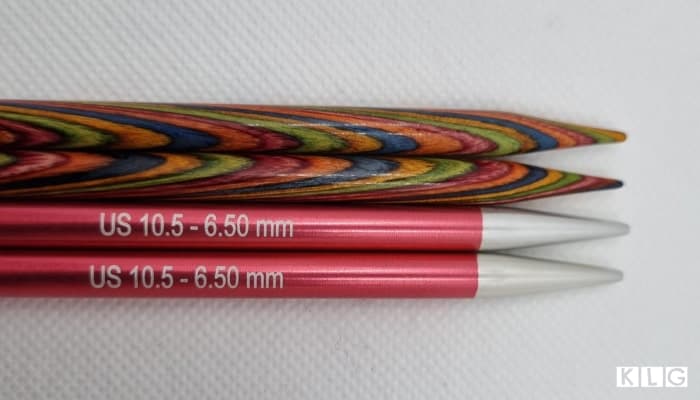
Note: If you click a link on this page and make a purchase, I may receive a commission, but at no extra cost to you. Learn More.
I reviewed, fact checked and updated this post on Dec 20, 2023.
Table of Contents
- Best Knitting Needles
- Diameter & Length
- Knitting Needle Sizes
- Knitting A Test Swatch
- Needle Materials Used
- Types
- Best Knitting Needles Brand
- Where To Buy Knitting Needles
- Storage Solutions
- FAQS
Best Knitting Needles
- Clover Takumi Straight Needles – Best Bamboo Straight Needles
- Chiaogoo Red Lace – Best Sock Knitting Needles
- Hiya Hiya – Best Circulars
- Karbonz – Best Double-Pointed Needles
- Addi Lace – Best Lace Knitting Needles
- Lykke Deluxe Set – Best Wooden Interchangeable Set
Clover Takumi Straights
Made from Bamboo these single point needles have a slight grab. These are great needles for beginners, because the stitches don’t slip off easily.
Pros
- Lightweight
- Smooth to touch
- Won’t catch your yarn
- Comfortable to hold
- Renewable resource
Cons
- Some customers found the surface splinters
Chiaogoo Red Lace
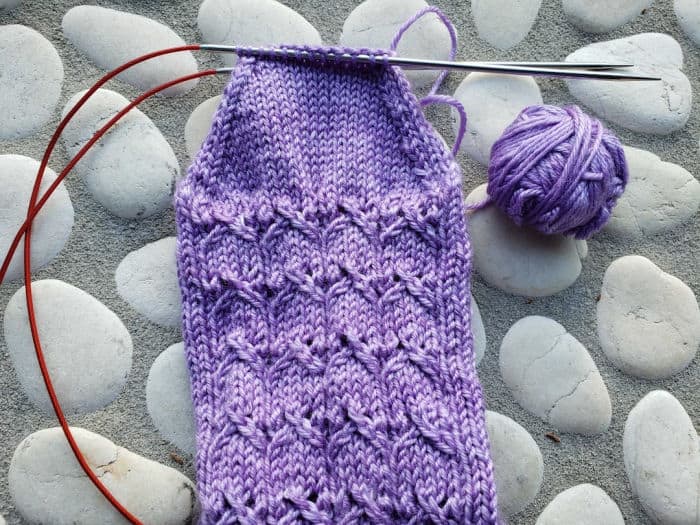
I love these needles. They’re the best knitting needle for socks using the magic loop method. The red nylon cables have stainless steel wire inside, don’t have memory and are sturdy.
The join is smooth and doesn’t snag the yarn. Stitches glide over the stainless steel surface of the tapered, sharp tips. Used for both flat knitting and knitting in the round, circular needles give flexibility.
Pros
- Lightweight
- Cable doesn’t kink
- Excellent range of needle sizes
Cons
- Don’t like the feel of metal? These aren’t for you
Hiya Hiya: Best Circular Needles With Good Sharp Tips
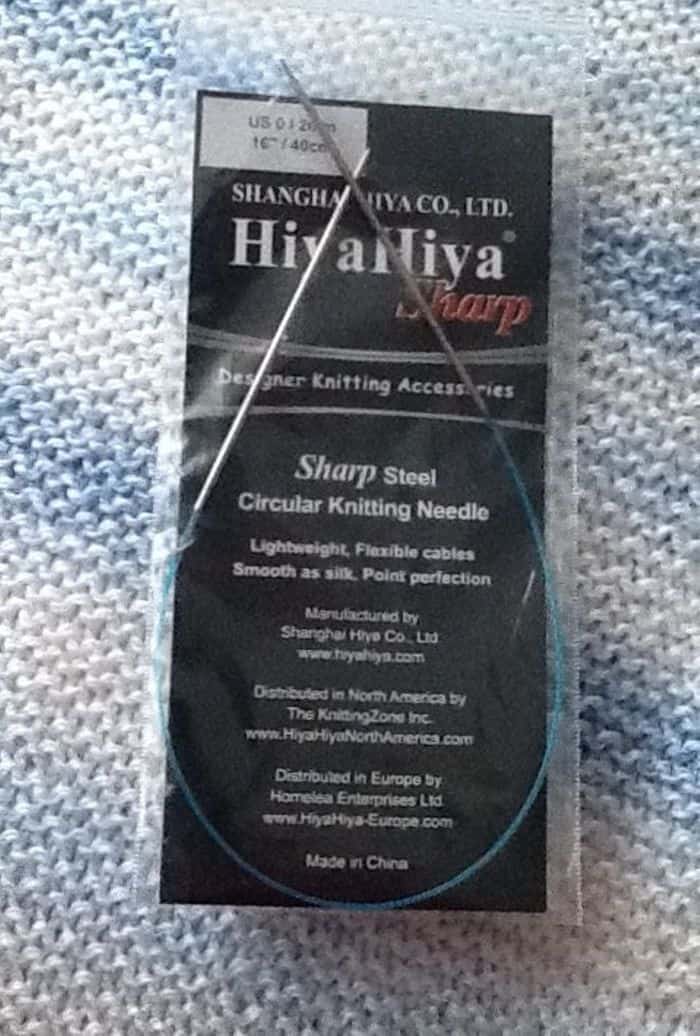
Like Chiaogoos, these stainless steel circulars are excellent for knitting projects in the round like sweaters, hats, cowls, and blankets/afghans.
Pros
- Flexible plastic cords
- Smooth join between tip and the cable
- Available in many sizes
- Lightweight
Cons
- A few people found the plastic cable had memory
Knitter’s Pride Karbonz Double-Pointed Needles
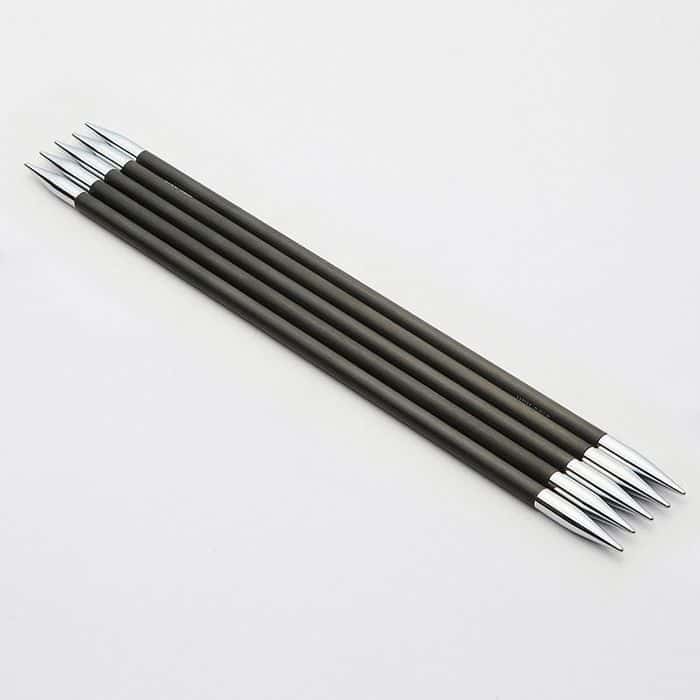
These pointy, good knitting needles made from carbon fiber from Knitter’s Pride are lightweight and have more grip than a stainless steel version.
Pros
- Durable
- This product type works with all yarn
Cons
- The tips are nickel plated bronze
- Smaller diameters may bend and break if not used gently
Addi Lace Sharps – Excellent For Lace Knitters
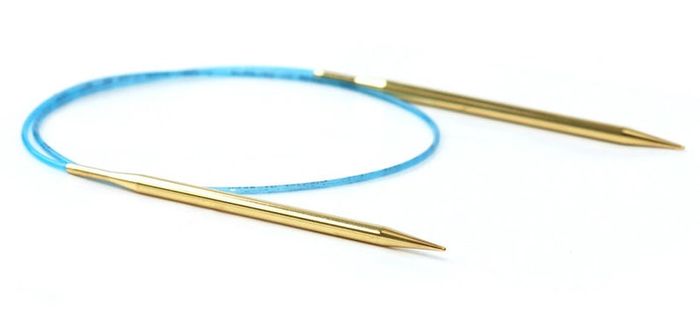
These circular knitting needles have pointy tips and a slick surface. Their popularity is well known in knitting circles. Use tip protectors when placed in a bag.
Pros
- Yarn glides easily over the surface
- Intricate stitches in a lace design are a breeze
- Excellent for speed knitters
- Comes in a range of sizes and cable lengths
Cons
- Pricier than other metal needles
Lykke Deluxe Wooden Knitting Needles: For Any Project
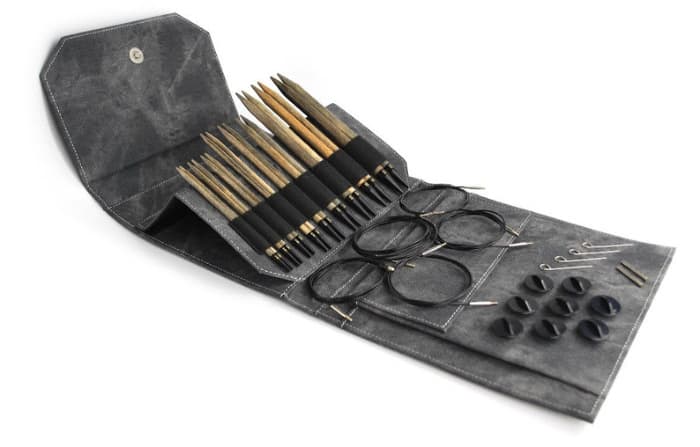
A luxury wooden interchangeable needles set have a lovely look and feel. Their products are handmade in Nepal by local craftspeople using local materials. They support their employees and their families and take care of the environment.
Pros
- A hardwood like maple in terms of density and bending strength
- The wood quickly adapts to your body temperature
- There is little friction or sticking when the yarn slides
- Cable connectors, keys & stoppers are included
- All parts of this wooden knitting needles set are stored in a stylish case.
- The convenience of having different combinations
Cons
- The cable color is dark and makes counting stitches difficult
- Fast knitters may not like it
- Not as pointy as a lace tip
Knit Picks Rainbow Laminated Birch Knitting Needles
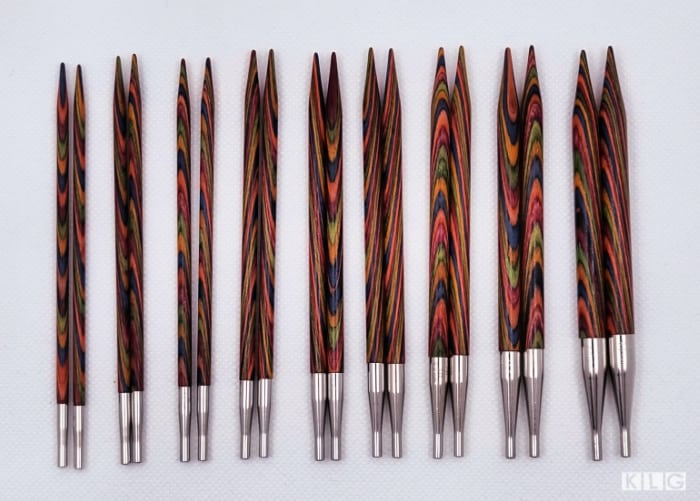
These colorful knitting needles are made of laminated birch wood and feature a lovely rainbow of gorgeous hues. The beautiful array of colors makes knitting fun!
Pros
- Smooth, comfortable wooden needles with pretty colors.
- Sharp tips and hardly noticeable join between needle and cord.
- Great for magic loop and lifelines.
- Comes with key to adjust cord length. Can make longer cords for big projects. Good for flat or small circumference knitting.
- Many size combinations.
Cons
- Size marking on needle can be hard to see, especially on smaller sizes. Keep in original packaging.
- Smaller needles can break if sat on accidentally. Store carefully!
Diameter & Length
Sizes used in a knitting project depend on the thickness of yarn, the stitch used, and the project design. They come in varying diameters and lengths. The needle diameter determines the stitch sizes.
Thicker needle – larger stitches, looser fabric. Smaller one – tiny stitches, tighter material. For example, a 5.5mm knitting needle produces a looser knit fabric than a 2mm one.
The project determines the length. Large project – longer needle or cord. Small, flat – any needle length. Socks – short circular needle or double-pointed needles.
- Straight needles – 10-16″ (25-40 cm)
- Circular needles – 12″ to 60″
If you have lots of stitches, you’ll need extra-long needles.
Different countries have different numbers/measures.
- Australia – metric sizes (millimeters) mm
- Canada – same as the UK
Knitting Needle Sizes – Everything You Need To Know
Everything you need to know about knitting needle size is shared in my article. Plus, a handy international conversion chart. Metric sizing, US sizes, UK sizes, and Japan sizing.
Knitting Needle Gauges
The knitting needle isn’t labeled with the size? Get a Knitting Needle Gauge.
Materials
Knitting needles are made from various substances. Read my list for more.
Bamboo
Bamboo is lightweight, but doesn’t slow you down much. Most of the knitting I do is on quality bamboo circular needles. I love the warm natural touch and feel. They’re the best knitting needles for knitting cotton dishcloths and hats.
Benefits: excellent for starting, they have a slight grip so knitted stitches don’t slide. They’re great for slippery yarns, made with sustainable materials, good for anyone who loves wooden options, and low cost.
Downsides: catches the yarn, and gets warm and sticky.
Bone
An ancient material like bamboo. Benefits: smooth, warm to the touch, a bit of grip, and slightly flexible. Downsides: expensive and hard to find.
Casein
Made from milk protein. They’re like plastic needles. They’re gorgeous and have tortoiseshell or pearly colors.
Benefits: nice colors, smooth, lightweight, warm in the hands, flexible, and quiet.
Downsides: They’re short and blunt, expensive, and hard to find.
Carbon Fiber
This high-tech material is light and non-slip. Popular with knitters using lace weight yarn, fine and silky yarns.
Benefits: Some don’t like brass, and others are sensitive. These are a great alternative. They’re also lightweight.
Downsides: these items are expensive and hard to find.
Glass
Yes, they exist! Usually Pyrex to make them durable.
Benefits: They’re beautiful and have an array of lovely colors and patterns. They’re smooth, but stitches don’t slide off accidentally, and they’re cool gifts for knitters.
Downsides: These accessories are breakable, and they have expensive prices.
Metal
Many knitters prefer the slippery coating on metal needles. They’re smooth and fast. Makes a real difference for your fast knitting needs! Here’s a selection of what they’re made from. Aluminum, Stainless steel, Brass, and Nickel plated.
A pair of metal needles has the pointiest tips. Excellent for certain yarn weights and knitting socks. The best knitting needles for lace and fingering yarns.
The pointy tips are great for intricate stitch work like lace or cable knitting. Most gold knitting needles are metal, coated in a gold finish.
Benefits: Durable, inexpensive, minimal friction, they suit hairy and fibrous yarns, they’re great for speed, and excellent for the magic loop.
Downsides: Cold, not suitable for learning to knit, hard, inflexible, and they click when knitting. Avoid this knitting needle material if you have tendonitis, Carpal Tunnel Syndrome, or Arthritis. The surface also gets scratched over time.
Plastic
Lightweight, smooth, and flexible. They’re warm in the hands after knitting. There are two variations. Normal grey and acrylic.
They’re subject to warping, but they’re great on a budget. They’re also excellent for flying. There are light-up needles of plastic with an LED light. Dozens of brands produce these types of needles.
Benefits: Plan on knitting with bulky yarn or using huge knitting needles? Choose these. They work with different weight yarns. They have many colors, so they’re good for encouraging young beginner knitters at an affordable price.
Downsides: They’re subject to warping, not too durable, and don’t last as long as some other materials.
Wood
Quiet and not slippery. They’re sometimes exotic woods and have carved ends or painted decorations. Colorful knitting needles are almost always made of wood.
Types Of Wood – Birch, Rosewood, and Ebony. Sometimes, wood is combined with metal, like in the Chiaogoo forte needles. It combines the best of both!
Benefits: Warmer in your hand and lighter than metal needles, they’re also smooth, and comfortable to use.
Downsides: They catch and slow you down, and they’ve got blunt tips.
Types
Beginning Knit Needles
On knitting forums, experienced knitters recommend bulky yarn for beginning knitters. This type of yarn uses thicker needles. Decide on the type of yarn and read the label. It tells you the best size needle.
Beginner knitting projects like a scarf have a suggested needle size. Gauge won’t matter so much. With complex patterns, start swatching.
Circulars
Fixed Circular needles are approx 5″ long connected by a flexible cord – nylon cords or plastic ones. Circular knitting Cord lengths vary: 16″-50″. The circulars come in plastic, metal, wood, or bamboo. Your choice depends on your material style preference in straight needles.
You rest the weight of the project in your lap. As a result, the knitting is lighter on your wrists. Hurrah for fewer pain problems!
Great for a variety of garments like a sweater. Sometimes they have lifeline holes for knitting things like lace projects. Circulars are essential for shawls. Small circular 9-inch sock knitting needles are popular with knitters.
Double Pointed Needles
Double point needles (DPNs) are short needles with points at both ends. A double-pointed needle is commonly sold in sets of 4 or 5. Designed for knitting in the round.
Newbies may have a problem with using Double Pointed versions, so practice some easier projects before attempting anything complicated. Best for socks, gloves, baby hats, adult hat crowns, or seamless sleeves.
Giant Needles
Size 50 Knitting needles come in straights and circulars. Light and versatile – for scarves, big throws, blankets, or rugs. Knitting with these takes practice. Not for people with wrist strain.
Ergonomic Needles
Designed for comfort and easier knitting. Great for any technique.
These are excellent if you have hand pain, hand strain, arthritis, carpal tunnel syndrome, or want something to keep knitting for longer.
Handmade Needles
Some lovely handcrafted needles are often made of wood or bamboo. They’re heirloom quality and last many years.
Hexagonal Needles
These look like a pencil. Indian Lake Artisans create beautiful wooden hexagonal-shaped needles.
Benefits: Multiple resting points for your fingers, you can relax your grip and still maintain control, and the stitch gauge remains the same. The yarn rests on the outer ends of the hex shape, and the needle wood tip is sharp.
Interchangeable Knitting Needle Sets
Interchangeable needle sets have short needle tips. These knitting tools combine to create circular needles of different lengths. Interchangeables are assembled by
- Screwing pieces together.
- Snapping in place
- Using a small key
A set of interchangeable knitting needles seems expensive and high-end. Considered luxury needles, interchangeables make life much easier. However, they’re cheaper than buying each separately.
They’re made from metal, wood, or durable plastic (Denise Interchangeables.)
Knitting Needles For Kids
Usually shorter in length than an average-sized needle and with blunter tips. These are specifically designed for small hands. They’re plastic but can be bamboo or wood too.
Square Needles
The square design of the needle shafts stops the needles from twisting as you knit. Knitters experience less tiredness in their hands and wrists. Many are wooden, but Knitter’s Pride uses metal. Most have to go up a size to get their standard gauge. Test it before taking on a new project with a differently shaped version.
Straight Needles
The most common type of knitting needle. (Aka single pointed needles.) These needles come in a needle set of two. Great for your first project! Common lengths are 7″ (good for children), 10″, 12″, and 14″.
Best for smaller projects like scarves, baby blankets, and wraps. Use end caps (point protectors) over each needle tip when taking a rest from your knitting. This stops the stitches from falling off the needles.
Vintage Needles
From the 1980s to as far back as the 1920s. A favorite of collectors and knitters who like lightweight needles.
Pin For Later

Best Knitting Needles Brand
Here are some choices of knitting needle manufacturers.
- Addi – German company. Known for slick, fast aluminum and metal.
- Aero – Vintage aluminum from the 60s, 70s, & 80s. They last a lifetime
- Boye – Affordable, and great for new knitters.
- Brittany – Sustainable family-owned US business. Uses birch.
- Bryspun – Designed for arthritis, hand strain, or carpal tunnel syndrome.
- ChiaoGoo – Chinese family-owned giant. Various needle types and materials, like the Chiaogoo twist interchangeable.
- Clover – Japanese company. Known for smooth bamboo.
- Crystal Palace – Polished and cured bamboo from Japanese bamboo in Japan
- Deborah Norville – Manufactured by Premier Yarns, with smooth birch wood
- Denise – Small USA family business. Interchangeable plastic.
- Furls – Beautifully handcrafted wooden straights.
- Hiya Hiya – Known for their sharp metal.
- Hobby Lobby – Stocks generic ones and some from well-known brands.
- KA (Kinki Amibari) – High-quality bamboo.
- Knit Picks – Made from laminated birch. Knit Picks needles interchangeable are fantastic!
- Knitter’s Pride – KnitPro in Europe, they have various needle styles.
- Kollage – Square ones designed for comfort and ease of use.
- Inox – A subsidiary of Prym, these are made of smooth aluminum.
- Lantern Moon – Luxury Needles of Ebony Wood.
- Lykke – Handmade birch in Nepal by local craftspeople.
- Neko – Curved DPNs, a unique take optimized for comfort.
- Pony – A company based in India produces various needles
- Prym – Specializes in ergonomic, comfortable and smooth plastic.
- Signature Needles – A family US business. Luxury colored aluminum.
- Susan Bates – Perfect for novices, these are affordable and versatile.
- Tulip – Using local bamboo, they’re quality and well made.
Where To Buy Knitting Needles Online: see my top recommendations.
Storage Solutions
Find solutions in my post knitting needle storage, or try specific products like a knitting needle case, or knitting needle organizer, for your knitting supplies.
FAQs About Knit Needles
This should be a fun crafting activity, too!
How Do You Make Knitting Needles?
Here is an excellent tutorial on making knitting needles by Pepper And Pine on Youtube.
What’re The Three Styles Of Knitting Needles?
The three styles of knitting needles are straight needles, double-pointed needles, and circular needles. Some work better with some knitting styles than others, but continental knitting suits all three.
What’s The Most Commonly Used Knitting Needle?
The most commonly used knitting needles are straight knitting needles, consisting of two pointed sticks.
What’re The Most Versatile Knitting Needles?
The most versatile knitting needles are circulars, as they have many uses.
Conclusion
Plenty of helpful knowledge about the best knitting needles. I hope my buying guide helped you out. Have any questions? Have a product purchase you love and want to let me know? Leave a comment. Your email address is never made public.


Hi I am just starting out. Would like to know what type and size needle to buy. Thanks.
Hi Mary Jo. I’d try plastic needles, as they’re inexpensive. Size US 10 (6mm) is good. Start with a shorter length, anywhere up from 8″ (20cm) Cheers Jodie
Would square needles be best for children as the advantages for the disabled would be the same as for those starting out, e.g easy grip, less slip off?
Hi Margaret. That’s a very good question. I am always impressed with kids’ ability to learn a new skill. Trying tubular needles first and see how they go would be my recommendation. I say that because there are so many to choose from including size and material they are made from. Cheers Jodie
Hello I have just completed a cream Aran jumper for my grandson. Half way through knitting the coating wore off the metal needles I used and the knitting is now a distinct gray colour when compared with the part where the needles were still coated. Only became obvious when put together. What is the best way to try and restore the cream colouor and get rid of the gray?
Hi Sue. Thanks for getting in touch. How frustrating to find that the needles’ coating has discolored the cream yarn you used. Do you know the brand of these needles? It might be an idea to get in touch with the company’s customer service and see what they suggest. I’d try doing a small swatch with any left over yarn and the same needles to recreate the discoloration. Then wash the swatch (cold water) with a small amount of wool wash and give it a good rinse see if the gray comes out. Then let it dry and see what it looks like. This is so you don’t have to wash your entire jumper. If the gray comes out in the swatch, it should come out in the jumper when you wash and block it. I am doing some research for you and if I find anything from other experts, I will let you know. Cheers Jodie
Hi Jodie I am a newbie to knitting I learned English knitting from Marly Bird and now I am learning continental from her. I absolutely love bamboo needles since I have had 3 carpal tunnel surgeries and arthritic fingers. I would like to know if there is a specific needle that can help with my essential tremors. Maybe a little weight on the end this would help so much. I really enjoyed this article.
Hi Lisa. That’s fantastic that you are learning the techniques of knitting. Welcome to our wonderful community.
I hope the surgeries have helped you. Be sure to take regular breaks and do some gently hand exercises. I will do some research about a specific needle to help with your tremors.
Are you using straight needles? I wonder if you could get custom made needles with a medium weight bead on the end? I’ve just done a quick search on Etsy and there are lots of options.
The other thing I’ve heard is that square wooden needles have helped people with hand pain. Kollage Needles are highly recommended but they are not bamboo.
Another option is Rosewood Cubics from Knitter’s Pride/KnitPro
I will get back to you with what I’ve found out. Cheers Jodie
Hi Jodie!
This is helpful info. Do you know if the Hiya Hiya tips are interchangeable with Clover Takumi? I need the small tips size 0,1,2 and Clover does not make them. I have the set of Clover interchangeables.
Thank you!
Hi Cynthia. I’ve done a little bit of research and I understand that the Clover Takukmi cables have a connection a little longer than the Hiya Hiya. Both brands have a screw connection but it looks like they are not interchangeable. Cheers Jodie